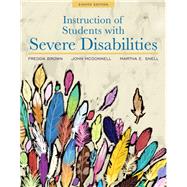This title is only available as a loose-leaf version with Pearson eText.
In this authoritative guide, leading scholars and researchers present information and evidence-based practices for dealing with the full range curriculum and instruction for individuals with severe intellectual disabilities and autism. The case studies throughout Instruction of Students with Severe Disabilities look at students of various ages and with a variety of disabilities, and each chapter includes an application to a student with autism. The content is presented with citations of supportive research, and the evidence-based practices are presented in clearly defined ways to ensure that teachers understand the practices and how to apply them in their own classrooms. PowerPoint slides created by the chapter authors are available for course instructors.
0134043383 / 9780134043388 Instruction of Students with Severe Disabilities, Pearson eText with Loose-Leaf Version -- Access Card Package, 8/e
Package consists of:
- 013382716X / 9780133827163 Instruction of Students with Severe Disabilities, Loose-Leaf Version
- 0134047982 / 9780134047980 Instruction of Students with Severe Disabilities, Pearson eText - Access Card








